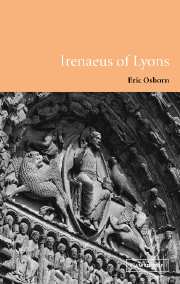Book contents
- Frontmatter
- Contents
- Preface
- List of abbreviations
- Chapter 1 Irenaeus: argument and imagery
- Part I DIVINE INTELLECT
- Part II ECONOMY
- Part III RECAPITULATION
- Part IV PARTICIPATION
- Chapter 7 Logic and the rule of truth: participation in truth
- Chapter 8 Scripture as mind and will of God: participation in truth
- Chapter 9 Aesthetics: participation in beauty
- Chapter 10 Human growth from creation to resurrection: participation in life
- Chapter 11 Goodness and truth: ethics of participation
- Part V CONCLUSION
- Appendix: Gnosticism
- Select bibliography
- Citations from Irenaeus
- Citations from the bible
- Index of classical authors
- Index of patristic authors
- General index
Chapter 9 - Aesthetics: participation in beauty
Published online by Cambridge University Press: 22 September 2009
- Frontmatter
- Contents
- Preface
- List of abbreviations
- Chapter 1 Irenaeus: argument and imagery
- Part I DIVINE INTELLECT
- Part II ECONOMY
- Part III RECAPITULATION
- Part IV PARTICIPATION
- Chapter 7 Logic and the rule of truth: participation in truth
- Chapter 8 Scripture as mind and will of God: participation in truth
- Chapter 9 Aesthetics: participation in beauty
- Chapter 10 Human growth from creation to resurrection: participation in life
- Chapter 11 Goodness and truth: ethics of participation
- Part V CONCLUSION
- Appendix: Gnosticism
- Select bibliography
- Citations from Irenaeus
- Citations from the bible
- Index of classical authors
- Index of patristic authors
- General index
Summary
Irenaeus' demand for truth and reason is joined by his sense of perception. He is visually oriented (homme du ‘voir’). From the beginning we have found in Irenaeus the two criteria of truth and fitness, the logical and the aesthetic. Participation in truth, through the rule, ended in consonantia, a harmony at once logical and aesthetic, while the truth of scripture was governed by a rebirth of images. In this chapter we shall review the persistence of the aesthetic criterion, then note how a modern theologian used Irenaeus to support his claim that theology should be aesthetic rather than logical. Early Christian art echoes the imagery of Irenaeus. The manifestation of God enables participation in divine beauty. The vision of divine glory brings participation in life.
PERSISTENCE OF AESTHETICS
A rapid recall of earlier chapters indicates the persistence of perception in the thought of Irenaeus. When he speaks of his youth and Polycarp, he explains how visual and aural memories persist in the mind. He can go back to encounters with Polycarp with a clear recollection of where the master was teaching, how he spoke, and what he said. The freshness of the image underlines his power of perception. On the other hand, Irenaeus' objection to gnosis is linked, from the beginning, to the need for vision and light. Despite the visionary qualities of Valentinus, his followers love the darkness and wish to remain unseen. Irenaeus is concerned to spread light and to uncover what is hidden.
- Type
- Chapter
- Information
- Irenaeus of Lyons , pp. 193 - 210Publisher: Cambridge University PressPrint publication year: 2001

